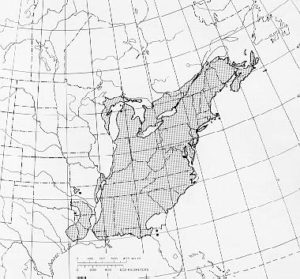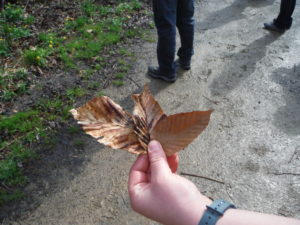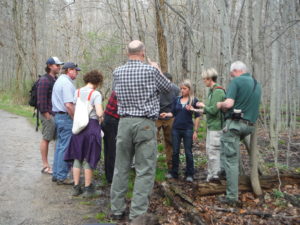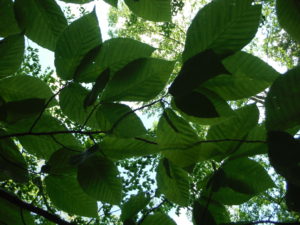last year’s leaves showing symptomatic striping (F.T. Campbell)
Back in December I blogged about beech leaf disease, a disease affecting American beech in northeastern Ohio and neighboring parts of Pennsylvania and New York, as well as across Lake Erie in Ontario.
[For more information and photos of symptoms, visit
http://forestry.ohiodnr.gov/portals/forestry/pdfs/BLDAlert.pdf or
https://www.cleveland.com/metro/index.ssf/2017/12/beech_leaf_disease_discovered.html]
Scientists do not know what is causing the disease. So far it’s only clear that it appears to have been introduced to a single site and is spreading. At the beginning of May I participated in a workshop providing the most recent information on beech leaf disease.
workshop participants (budbreak was later than usual, so we could not observe deformed leaves) (F.T. Campbell)
Over the past three or four years, scientists have tried hard to understand the disease, its causes, and its likely prognosis. For example, scientists from the U.S. Department of Agriculture and the State of Ohio have looked for insects, fungal pathogens, bacteria, viruses, nematodes, phytoplasmas – all without finding a causative agent. Attention is currently focused on a previously undescribed nematode in the Litylenchus genus. The only other species in this genus is a foliar feeder found in New Zealand. Studies continue, with most scientists tackling the problem without special funding.
Beech is a very important component of the forests of northeastern Ohio. Beech ranks third in number of stems per acre; second for “shrubs”. Consequently, scientists working for Lake Metroparks and Cleveland Metroparks continue to monitor spread of the disease and its impacts. Symptoms – deformed leaves – were first detected in 2012. In 2017, the results of a long-term vegetation monitoring project revealed that of 307 plots with beech present, 154 had symptomatic trees. Of the symptomatic plots, 49% of beech stems were affected. While initially only small trees had been killed, more recently some larger ones have died and others bear only very few leaves. Leaves with light, medium, or heavy symptoms of infection – as well as asymptomatic leaves – can occur on the same branch of an individual tree.
The disease seems to spread faster between stems along the interlocking roots of beech clone clusters.
Weather does not appear to be a factor, as the disease has spread every year despite great variations in heat and cold as well as levels of moisture.
Preliminary versions of a mathematical model of the disease’ spread indicates that approximately 90% of monitoring plots deployed across the full 24,000 acres of Cleveland Metropark system will be infected within 10 years.
Cleveland Metroparks has initiated intensive monitoring of a subset of 13 plots in order to clarify the disease’s impact. Monitoring revealed a 4% mortality rate from 2015 to 2017. More than half of these plots now have dead beech that had previously been symptomatic. Most are small trees less than 4.9 cm dbh. Efforts to obtain funding from the USFS Forest Health program have so far failed.
The disease – whatever its cause! – appears to be moved by trade in nursery plants. An Ontario retailer received – and rejected – a shipment of diseased beech from an Ohio nursery. Lake County, Ohio, has many nurseries that grow and ship European beech (which can also be infected by beech leaf disease). These nurseries are reported to be cooperating with Ohio authorities. No official entity has imposed regulatory restrictions – not any of the states or provinces with the disease present or threatened by it; nor USDA APHIS or the Canadian Food Inspection Agency (CFIA).
Another threat to beech also not under regulation
CFIA has also not imposed a federal quarantine on another non-native pest killing beech, the European leaf-mining weevil, Orchestes fagi. First discovered in Halifax in 2012 – probably 5 years after its introduction – it has since spread throughout Nova Scotia. The weevil kills beech over 3 – 5 years.
New information added in June: according to Meurisse et al. (2018), the weevil overwinters under the bark of beech and trees that are not hosts, so it can be transported by movement of firewood and other forms of unprocessed logs and branches. [Meurisse, N. D. Rassaati, B.P. Hurley, E.G. Brockerhoff, R.A. Haack. 2018. Common Pathways by which NIS forest insects move internationally and domestically. Journal of Pest Science. https://doi.org/10.1007/s10340-018-0990-0]
The Importance of American Beech – and Protecting It
Beech is an extremely important tree in northern parts of the United States and Canada east of the Great Plains. It is co-dominant (with sugar maple) in the Northern Hardwood Forest [see two maps]. A summary of the species’ ecological importance can be found in Lovett et al. 2006. Forest Ecosystem Responses to Exotic Pests and Pathogens in Eastern North America. BioScience Vol. 56 No. 5.
 native range of American beech; USFS map
native range of American beech; USFS map
Consequently, I am most distressed by the lack of attention to these new threats to the species. It is true that regulating an unknown disease agent (as would be the case with beech leaf disease) stretches traditional policy practice and possibly legal authorities. Furthermore, it has not yet been demonstrated that the disease can kill mature beech. However, neither of these caveats applies to the weevil, which is an identified species that has been documented to kill mature trees.
U.S. phytosanitary officials (the National Plant Board) will meet in Cleveland (!!) in August. Will the several state officials and their APHIS colleagues discuss how to address this new threat? Will any funds be made available to expand efforts to understand the disease, its spread, and possible measures to curtail it?
healthy beech, northern Virgina (F.T. Campbell)
Posted by Faith Campbell
We welcome comments that supplement or correct factual information, suggest new approaches, or promote thoughtful consideration. We post comments that disagree with us — but not those we judge to be not civil or inflammatory.



First year in Northern NY Carthage NYspecifically
BLD has taken hold of the Beech trees in this area. Those white hairs found by Dave McCann convinced me .